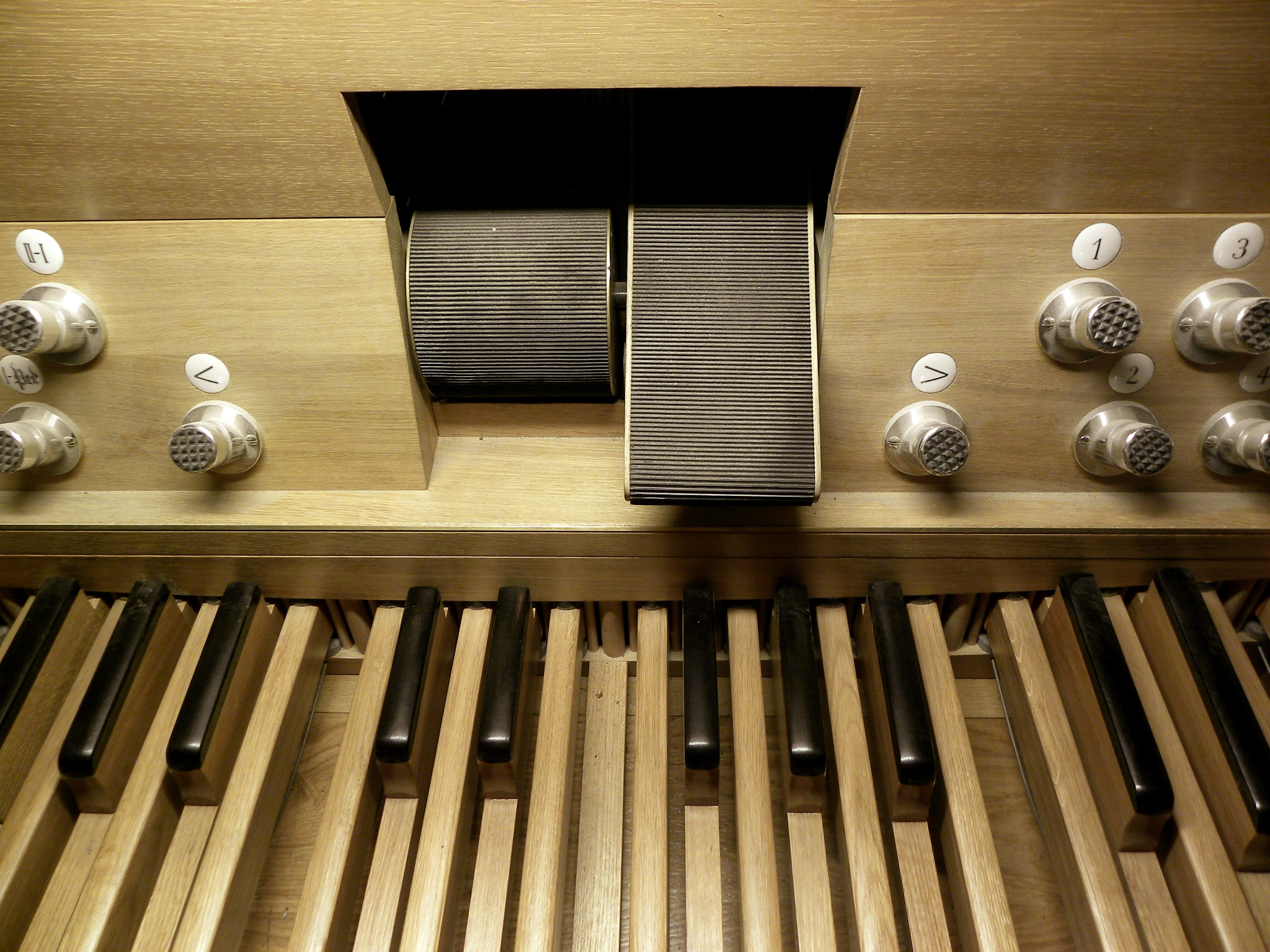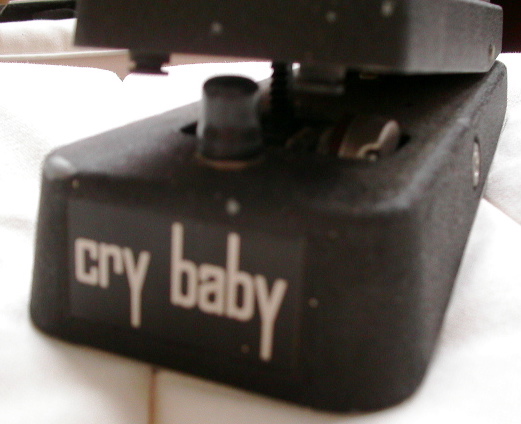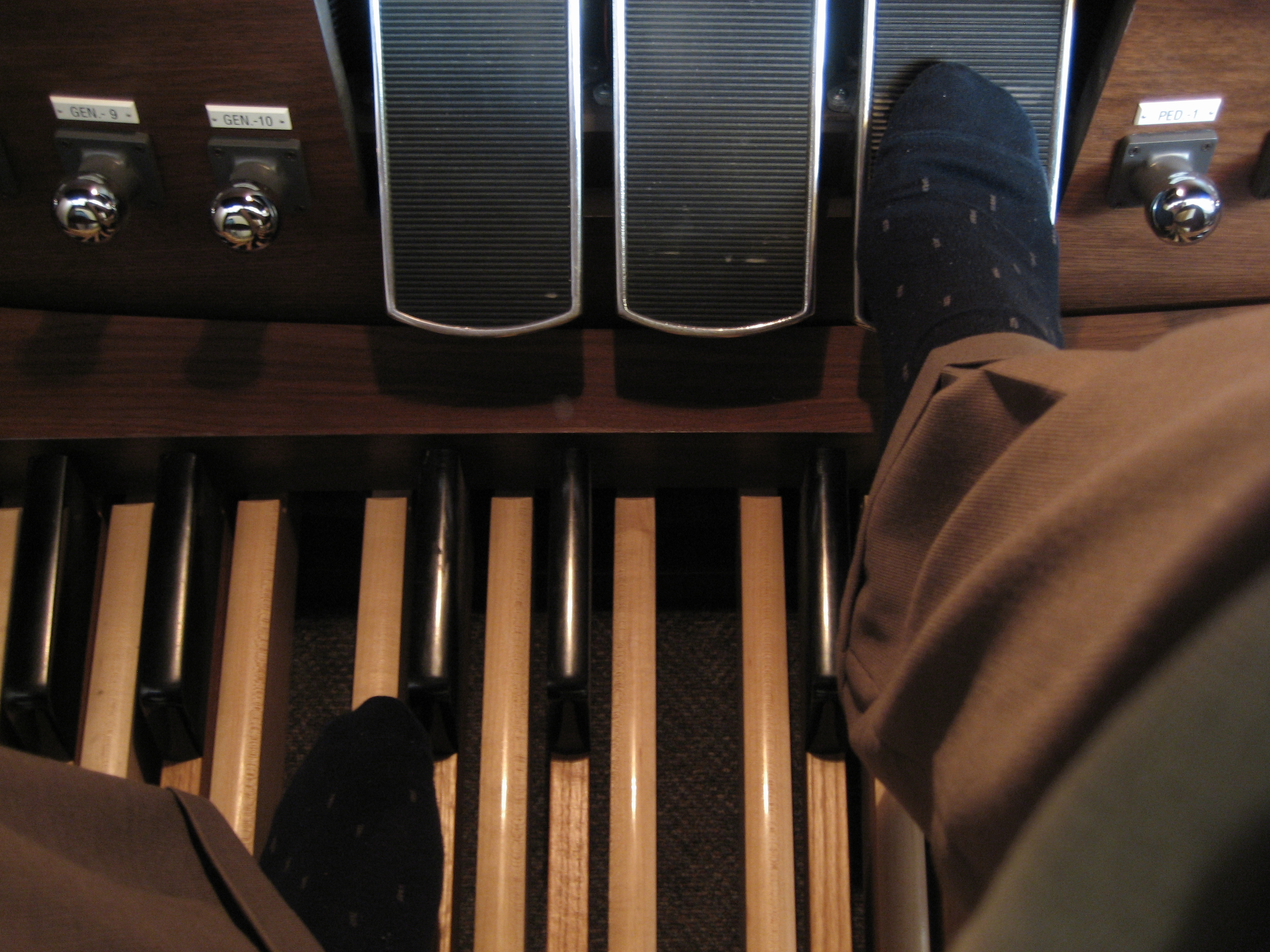|
Expression Pedal
An expression pedal is an important control found on many musical instruments including organs, electronic keyboards, and pedal steel guitar. The musician uses the pedal to control different aspects of the sound, commonly volume. Separate expression pedals can often be added to a guitar amplifier or effects unit and used to control many different aspects of the tone. Because the source of power with a pipe organ and electronic organs is not generated by the organist, the volume of these instruments has no relationship with how hard its keys or pedals are struck; i.e., the organ produces the same volume whether the key or pedal is depressed gently or firmly. Moreover, the tone will remain constant in pitch, volume, and timbre until the key or pedal is lifted, at which point the sound stops. The expression pedal gives the organist control over the external source of power, and thus the volume, of the instrument, while leaving the user's hands free. This system of dynamic control ... [...More Info...] [...Related Items...] OR: [Wikipedia] [Google] [Baidu] |
Holtkamp
The Holtkamp Organ Company of Cleveland, Ohio is United States, America's oldest continuously operating pipe organ workshop. The company was founded in 1855 by Gottlieb Votteler. The work produced by the shop has evolved over the years in terms of architectural style, sound, and mechanism. During this time, the company has had a number of names, including: The Votteler Organ Company, The Votteler-Hettche Organ Company, The Votteler-Holtkamp-Sparling Organ Company, and finally in 1951, The Holtkamp Organ Company. When Gottlieb Votteler opened his shop for building pipe organs in Cleveland in 1855, he built small instruments with mechanical Action (piano), key action and mechanical Organ stop, stop action. During the Votteler-Hettche years, robust mechanical actions were replaced with Tubular-pneumatic action, tubular–pneumatic actions, transitioning to Electro-pneumatic action, electro-pneumatic actions in the Votteler-Holtkamp-Sparling years, and Holtkamp Organ years. Currently ... [...More Info...] [...Related Items...] OR: [Wikipedia] [Google] [Baidu] |
Wah-wah Pedal
A wah-wah pedal, or simply wah pedal, is a type of effects pedal designed for electric guitar that alters the timbre of the input signal to create a distinctive sound, mimicking the human voice saying the onomatopoeic name "wah-wah". The pedal sweeps a band-pass filter up and down in frequency to create a spectral glide. The wah-wah effect originated in the 1920s, with trumpet or trombone players finding they could produce an expressive crying tone by moving a mute in, and out of the instrument's bell. This was later simulated with electronic circuitry for the electric guitar when the wah-wah pedal was invented. It is controlled by movement of the player's foot on a rocking pedal connected to a potentiometer. Wah-wah effects may be used without moving the treadle as a fixed filter to alter an instrument’s timbre (known as a "cocked-wah"), or to create a "wacka-wacka" funk-styled rhythm for rhythm guitar playing. An auto-wah pedal uses an envelope follower to control th ... [...More Info...] [...Related Items...] OR: [Wikipedia] [Google] [Baidu] |
Organ Repertoire
The organ repertoire is considered to be the largest and oldest repertory of all musical instruments. Because of the organ's (or pipe organ's) prominence in worship in Western Europe from the Middle Ages on, a significant portion of organ repertoire is sacred in nature. The organ's suitability for improvisation by a single performer is well adapted to this liturgical role and has allowed many blind organists to achieve fame; it also accounts for the relatively late emergence of written compositions for the instrument in the Renaissance. Although instruments are still disallowed in most Eastern churches, organs have found their way into a few synagogues as well as secular venues where organ recitals take place. Renaissance The earliest surviving keyboard compositions (keyboard music was not instrument-specific until the sixteenth century) are from England ( Robertsbridge Codex c. 1365) and Italy ( Faenza Codex, 15th century). The organ is specified in Marco Antonio Cavazzoni's ... [...More Info...] [...Related Items...] OR: [Wikipedia] [Google] [Baidu] |
Jazz
Jazz is a music genre that originated in the African-American communities of New Orleans, Louisiana, in the late 19th and early 20th centuries. Its roots are in blues, ragtime, European harmony, African rhythmic rituals, spirituals, hymns, marches, vaudeville song, and dance music. Since the 1920s Jazz Age, it has been recognized as a major form of musical expression in traditional and popular music. Jazz is characterized by swing and blue notes, complex chords, call and response vocals, polyrhythms and improvisation. As jazz spread around the world, it drew on national, regional, and local musical cultures, which gave rise to different styles. New Orleans jazz began in the early 1910s, combining earlier brass band marches, French quadrilles, biguine, ragtime and blues with collective polyphonic improvisation. However, jazz did not begin as a single musical tradition in New Orleans or elsewhere. In the 1930s, arranged dance-oriented swing big bands, ... [...More Info...] [...Related Items...] OR: [Wikipedia] [Google] [Baidu] |
Pump Organ
The pump organ or reed organ is a type of organ that uses free reed aerophone, free reeds to generate sound, with air passing over vibrating thin metal strips mounted in a frame. Types include the pressure-based harmonium, the suction reed organ (which employs a vacuum system), and the Indian harmonium. Historical examples include the ''Kunstharmonium'' and the American reed organ, while earlier forms include the physharmonica and the Seraphine (instrument), seraphine. More portable than pipe organs, free-reed organs became widespread in smaller churches and private homes during the 19th century, although their volume and tonal range were limited. They generally featured one, or occasionally two, Manual (music), manuals, while pedal keyboard, pedal-boards were rare. Higher-end pump organs offered a broader range of tones, and models intended for churches or affluent households were often housed in finely crafted Cabinet (furniture), cabinets. Between the 1850s and the 1920s, se ... [...More Info...] [...Related Items...] OR: [Wikipedia] [Google] [Baidu] |
Reed Organ
The pump organ or reed organ is a type of organ that uses free reeds to generate sound, with air passing over vibrating thin metal strips mounted in a frame. Types include the pressure-based harmonium, the suction reed organ (which employs a vacuum system), and the Indian harmonium. Historical examples include the ''Kunstharmonium'' and the American reed organ, while earlier forms include the physharmonica and the seraphine. More portable than pipe organs, free-reed organs became widespread in smaller churches and private homes during the 19th century, although their volume and tonal range were limited. They generally featured one, or occasionally two, manuals, while pedal-boards were rare. Higher-end pump organs offered a broader range of tones, and models intended for churches or affluent households were often housed in finely crafted cabinets. Between the 1850s and the 1920s, several million reed organs and melodeons were manufactured in the United States and Canada ... [...More Info...] [...Related Items...] OR: [Wikipedia] [Google] [Baidu] |
The Church Of St Mary In East Walton - Harmonium - Geograph
''The'' is a grammatical article in English, denoting nouns that are already or about to be mentioned, under discussion, implied or otherwise presumed familiar to listeners, readers, or speakers. It is the definite article in English. ''The'' is the most frequently used word in the English language; studies and analyses of texts have found it to account for seven percent of all printed English-language words. It is derived from gendered articles in Old English which combined in Middle English and now has a single form used with nouns of any gender. The word can be used with both singular and plural nouns, and with a noun that starts with any letter. This is different from many other languages, which have different forms of the definite article for different genders or numbers. Pronunciation In most dialects, "the" is pronounced as (with the voiced dental fricative followed by a schwa) when followed by a consonant sound, and as (homophone of the archaic pronoun ''thee' ... [...More Info...] [...Related Items...] OR: [Wikipedia] [Google] [Baidu] |
The Musical Times
''The Musical Times'' was an academic journal of classical music edited and produced in the United Kingdom. It was originally created by Joseph Mainzer in 1842 as ''Mainzer's Musical Times and Singing Circular'', but in 1844 he sold it to Alfred Novello (who also founded '' The Musical World'' in 1836), and it was published monthly by Novello and Co. (also owned by Alfred Novello at the time). It first appeared as ''The Musical Times and Singing Class Circular'', a name which was retained until 1903. From the very beginning, every issue – initially just eight pages – contained a simple piece of choral music (alternating secular and sacred), which choral society members subscribed to collectively for the sake of the music. Its title was shortened to its present name from January 1904. Even during World War II it continued to be published regularly, making it the world's oldest continuously published periodical devoted to western classical music. In 1947 a two volume compila ... [...More Info...] [...Related Items...] OR: [Wikipedia] [Google] [Baidu] |
Crescendo Pedal
A crescendo pedal is a large pedal commonly found on medium-sized and larger pipe organs (as well as digital organs), either partially or fully recessed within the organ console. The crescendo pedal incrementally activates stops as it is pressed forward and removes stops as it is depressed backward. The addition of stops, in order from quietest to loudest, creates the effect of a crescendo (and, likewise, a diminuendo, when the stops are deactivated). In actual use, the operation of the crescendo pedal usually does not move the draw knobs or stop tabs on the console; the stops are electronically activated inside the organ. Often an indicator light or lights will be present on the console to inform the organist of when the crescendo pedal is activated and how far it is engaged. The crescendo pedal is located directly above the pedalboard, to the right of any expression pedals that may be present. The earliest type of automatic crescendo device was the ''Rollschweller'' ( G ... [...More Info...] [...Related Items...] OR: [Wikipedia] [Google] [Baidu] |






